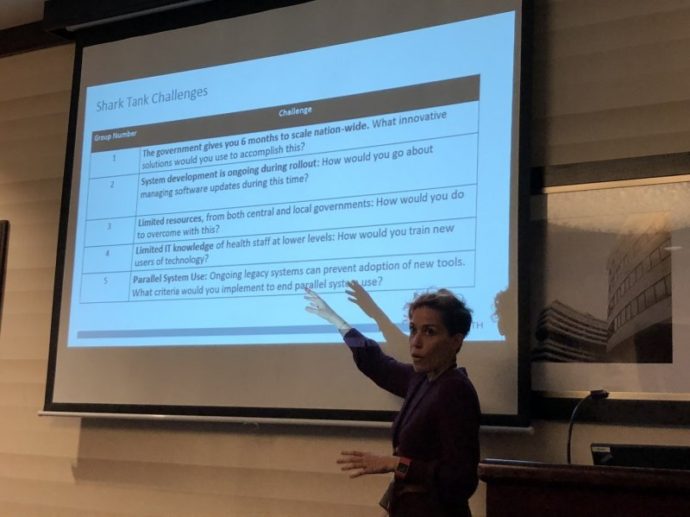“It doesn’t have to be like ripping off a Band-Aid”: Transitioning from paper to digital records
By Jarret Cassaniti, CCP Program Officer, K4Health
Jan 24, 2018
Posted in News, People, Policies & Practices

Photo: K4Health/Jarret Cassaniti. PATH’s Dawn Seymour discusses scenarios that implementers may face in transitioning from paper to digital records.
This post originally appeared on the K4Health blog.
During the 2017 Global Digital Health Forum session on Injecting Digital Technology into Old-School Immunization Systems, Dawn Seymour from PATH discussed the value of electronic immunization registries. Despite the benefits of such registries, including more accurate data, she and her colleagues Sang Dao Dinh and Hieu Tran explained some challenges when transitioning from legacy, paper-based systems in Zambia, Tanzania, and Vietnam to digital versions.
Across PATH, two initiatives are helping facilities transition to electronic immunization registries: the BID Initiative, which is being implemented in Tanzania and Zambia, and ImmReg, which began in 2012 in Vietnam. In addition to implementing registries as a tool to address data quality and use, the countries are striving for a culture of data use where reliable, easily accessed, and actionable data can be used to improve health outcomes. The accessibility and visibility of data through these electronic tools facilitates more reliable forecasting and supply chain management than paper records. They can also help managers recognize where they are making progress on service delivery goals and where they are falling short.
The package of data quality and use interventions that BID provides includes a component on the culture of data use. A white paper on the subject discusses how changing the culture of an organization takes time and that patience is important.
There is a significant learning curve associated with switching to a digital registry. In Zambia, many health workers have never used a computer before, and were skeptical about using these digital tools, such as the Zambia Electronic Immunization Registry (ZEIR), for the first time. With a user-centered design, ZEIR supports clinical workflows around childhood vaccination and growth monitoring. Because many health workers have relied on a paper system for much of their careers, the ZEIR user interface was designed to resemble familiar paper forms.
Seymour mentioned that some of the small challenges the teams have encountered present big questions. For instance, in some health system settings, it’s the responsibility of a facility in-charge to sign off on a report as part of the ownership of the data coming from his/her facility to the district for reporting. Since online repositories allow for real-time uploads of new data (and thus minimize the lag between collection and reporting), it’s important for owners of that data to be clear about review timeframes and how to sign off on that review process.
For this reason, Seymour advocates for changes to be rolled out incrementally. In Tanzania, where BID is partnering with the Ministry of Health, Community Development, Gender, Elderly and Children, the government is planning a gradual process, during which selected districts in regions already using the data quality and use interventions (including the electronic immunization registry) will stop using the legacy paper forms at specific times. This process ensures that facilities, districts, and the region have time to adjust and share lessons learned.
Small, deliberate steps can help minimize the learning curve, or as Seymour suggested, make the change less painful. As she says, it doesn’t have to be like ripping off a Band-Aid.
